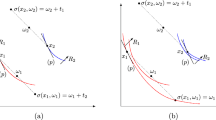Abstract
This paper solves the fair and optimal house allocation problem (Sun and Yang, Econ Lett 81:73–79, 2003) when the agents preferences are represented by nonlinear utility functions using techniques for global mixed integer nonlinear optimization. A small simulation study indicates that if quasi-linear specifications are adopted as approximations to nonlinear utility functions and if the fair and optimal allocation is identified based on this approximation, then the prices are typically higher on average and the resulting allocation is typically non-fair.
Similar content being viewed by others
References
Adjiman C.S., Androulakis I.P., Floudas C.A. (1998a) A global optimization method, αBB, for general twice-differentiable NLPs—II. Implementation and computational results. Computers and Chemical Engineering 22: 1159–1178
Adjiman C.S., Dallwig S., Floudas C.A., Neumaier A. (1998b) A global optimization method, αBB, for general twice-differentiable NLPs—I. Theoretical advances. Computers and Chemical Engineering 22: 1137–1158
Adjiman, C. S., Schweiger, C. A., & Floudas, C. A. (1998c). Mixed-integer nonlinear optimization in process synthesis. Handbook of combinatorial optimization, vol. 1. Kluwer Academic Publishers.
Adjiman C.S., Androulakis I.P., Floudas C.A. (2000) Global optimization of mixed-integer nonlinear problems. AIChE Journal 46: 1769–1797
Alkan A., Demange G., Gale D. (1991) Fair allocation of indivisible goods and criteria of justice. Econometrica 59: 1023–1039
Andersson T. (2007) An algorithm for identifying fair and optimal allocations. Economics Letters 96: 337–342
Andersson T., Svensson L.-G. (2008) Non-manipulable assignment of individuals to positions revisited. Mathematical Social Sciences 56: 350–354
Aragones E. (1995) A derivation of the money Rawlsian solution. Social Choice and Welfare 12: 267–276
Bussieck M.R., Drud A.S., Meeraus A. (2003) MINLPLib—a collection of test models for mixed-integer nonlinear programming. INFORMS Journal on Computing 15(1): 114–119
Chaudhuri A. (1986) Some implications of an intensity measure of envy. Social Choice and Welfare 3: 255–270
Crawford V., Knoer E. (1981) Job matching with heterogeneous firms and workers. Econometrica 49: 437–450
Deltas G. (2004) Asymptotic and small sample analysis of the stochastic properties and certainty equivalents of winning bids in independent private values auctions. Economic Theory 23: 715–738
Demange G., Gale D. (1985) The strategy structure of two-sided matching markets. Econometrica 53: 873–888
Demange G., Gale D., Sotomayor M. (1986) Multi-item auctions. Journal of Political Economy 94: 863–872
Grossman, I. E. (2002). Review of nonlinear mixed-integer and disjunctive programming techniques. Optimization and Engineering, 227–252.
Gupta O.K., Ravindran A. (1985) Branch and bound experiments in convex nonlinear integer programming. Managment Science 31(12): 1533–1546
Haake C.J., Raith M.G., Su F.E. (2002) Bidding for envy-freeness: A procedural approach to the n-player fair division problems. Social Choice and Welfare 19: 723–749
Klijn F. (2000) An algorithm for envy-free allocations in an economy with indivisible objects and money. Social Choice and Welfare 17: 201–216
Kuhn H. (1955) The Hungarian method for the assignment Problem. Naval Research Logistics Quarterly 2: 83–97
Maskin, E. (1987). On the fair allocation of indivisible goods. In G. Feiwell (Ed.), Arrow and the foundations of the theory of public policy (pp. 343–349). MacMillan Press.
Shioura A., Sun N., Yang Z. (2006) Efficient strategy proof allocation algorithms. Journal of the Operations Research 49: 144–150
Sun N., Yang Z. (2003) A general strategy proof fair allocation mechanism. Economics Letters 81: 73–79
Svensson L.-G. (1983) Large indivisibles: An analysis with respect to price equilibrium and fairness. Econometrica 51: 939–954
Tadenuma K., Thomson W. (1991) No-envy and consistency in economies with indivisible goods. Econometrica 59: 1755–1767
Williams H.P., Yan H. (2001) Representations of the all_different predicate of constraint satisfaction in integer programming. INFORMS Journal on Computing 13(2): 96–103
Author information
Authors and Affiliations
Corresponding author
Rights and permissions
About this article
Cite this article
Andersson, T., Andersson, C. Solving House Allocation Problems with Risk-Averse Agents. Comput Econ 33, 389–401 (2009). https://doi.org/10.1007/s10614-008-9166-y
Received:
Accepted:
Published:
Issue Date:
DOI: https://doi.org/10.1007/s10614-008-9166-y




